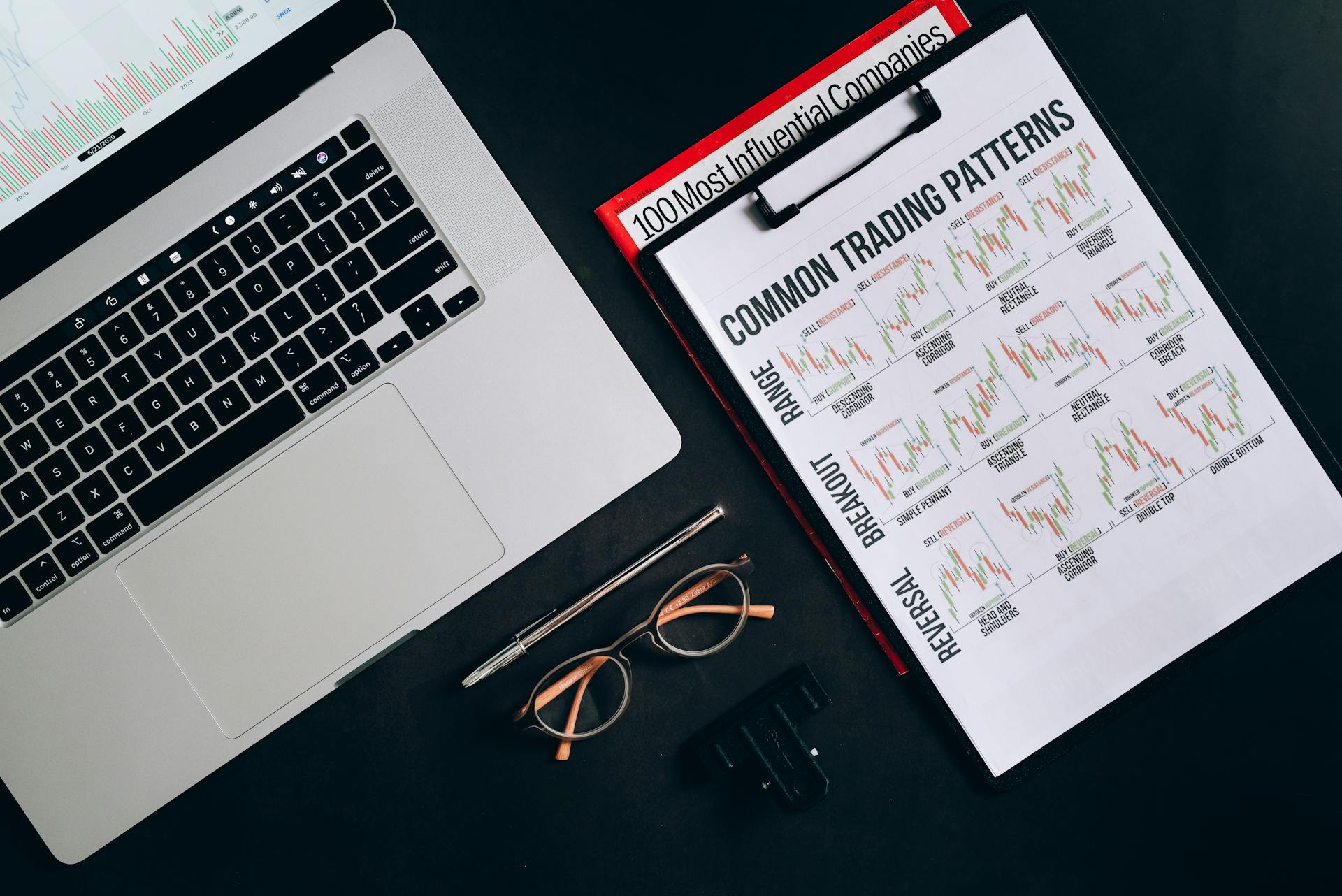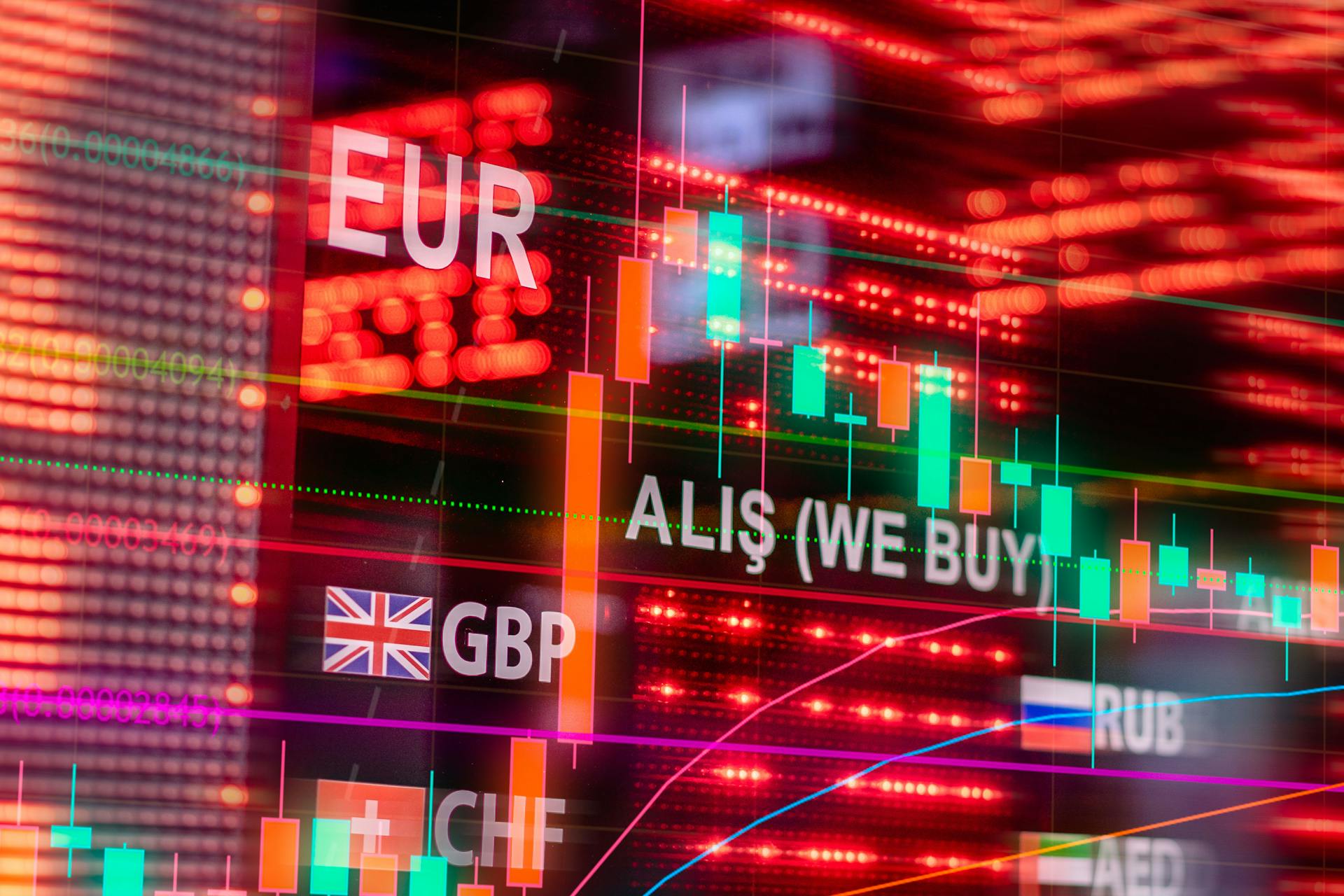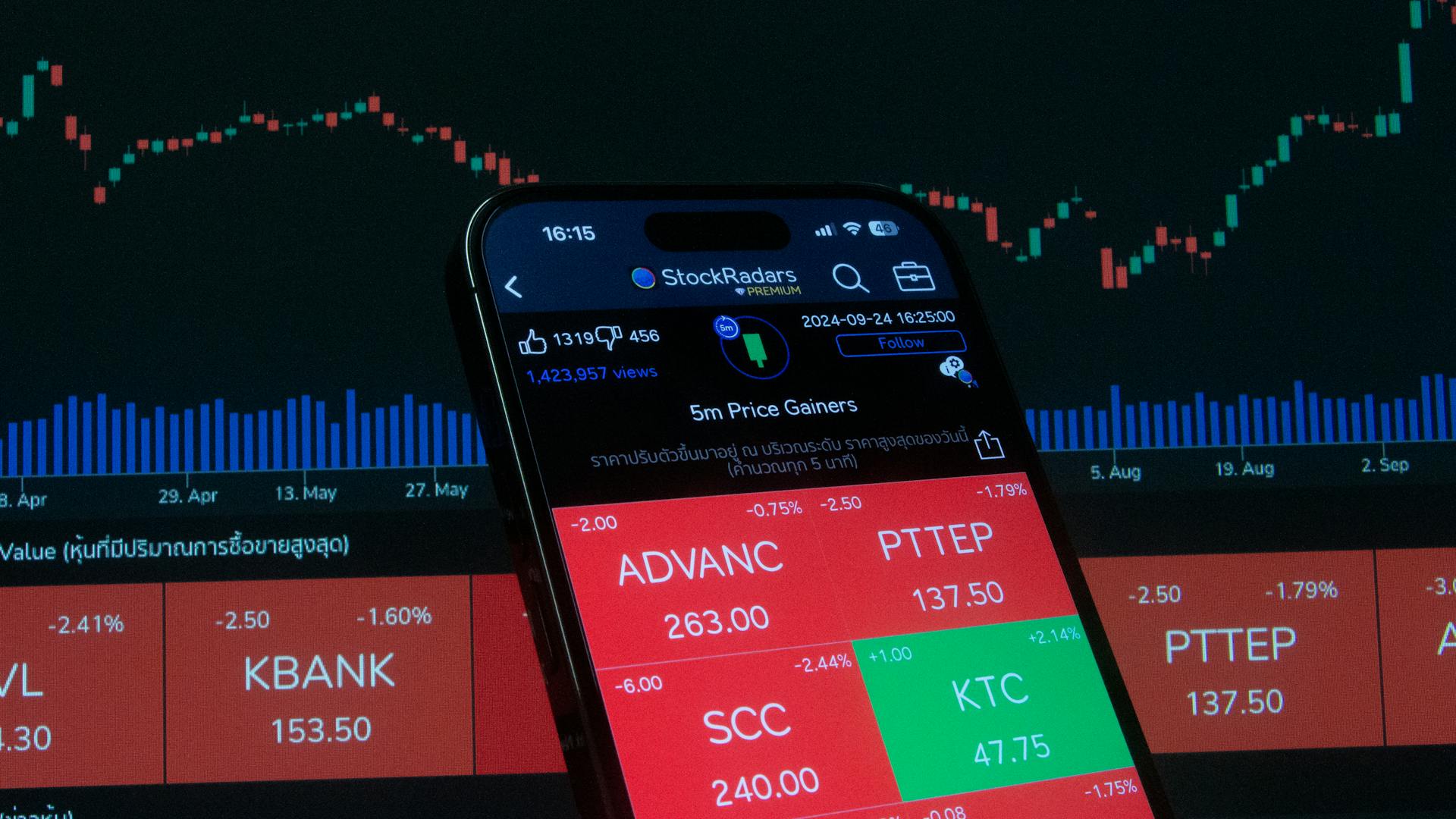
High-frequency trading (HFT) is a complex and often misunderstood topic. It involves using powerful computers and sophisticated algorithms to execute trades in fractions of a second, often at speeds that are faster than a human can react.
These lightning-fast trades can be executed in as little as 1-5 milliseconds, allowing HFT firms to capitalize on even the smallest market inefficiencies. This speed is made possible by the use of specialized hardware and software.
The goal of HFT is to make a profit from the tiny price differences that exist between different markets or exchanges. By executing trades at incredible speeds, HFT firms can exploit these differences and generate significant returns.
What Is HFT?
High-frequency trading, or HFT, is a trading method that uses powerful computer programs to transact a large number of orders in fractions of a second.
HFT relies on complex algorithms that analyze multiple markets and execute orders based on market conditions. These algorithms can spot emerging trends in milliseconds, making trades at incredible speeds.
Traders with the fastest execution speeds are generally more profitable than those with slower execution speeds. This is because HFT allows for quick reaction to market changes, giving traders a competitive edge.
HFT is usually used by large institutional investors like hedge funds and investment banks due to its complexity. Special computers are used to execute trades quickly, taking advantage of even the smallest market fluctuations.
HFT is characterized by high turnover rates and order-to-trade ratios, indicating a high volume of trades. This is because hundreds of buy orders can be sent out in seconds if the analysis finds a trigger.
Intriguing read: Fpga in Hft
Advantages and Disadvantages
High-frequency trading, or HFT, has both advantages and disadvantages. HFT has the ability to make quick profits by executing a lot of trades, making hefty profits through the bid-ask spreads. This is due to the powerful computers and software that can scan and analyze multiple markets simultaneously, allowing investors to find arbitrage opportunities and profit by buying on one exchange and quickly selling on the other.
HFT also enhances liquidity in the market, increasing competition and trade volume, which results in a decline in bid-ask spreads and more efficient prices. This makes the market more transparent and flexible, reducing the risk for other investors.
However, HFT has a few downsides. One of the main criticisms is that it lacks regulation, making it difficult to monitor and regulate due to its complex algorithms and software. This has led to a lack of transparency and understanding among scholars and finance professionals.
In addition, HFT has been criticized for replacing many brokers and dealers with software and algorithms, which is considered a bad process. This is because a comprehensive trading strategy cannot be based solely on data and information, and a person's intellect is required to make profits when investing.
The main benefit of HFT is the speed and ease with which transactions can be executed, allowing banks and other traders to execute a large volume of trades in a short period of time. This has improved market liquidity and removed bid-ask spreads that would have previously been too small.
Here are some key statistics on the impact of HFT on market liquidity:
Overall, HFT has both benefits and drawbacks, and it's essential to understand these advantages and disadvantages before investing in the market.
Market and Growth
High-frequency trading (HFT) experienced rapid growth in the early 2000s, with trading volume growing by about 164% between 2005 and 2009.
In the US, HFT firms represented 2% of all firms in 2009, but accounted for 73% of all equity orders volume. This is a staggering statistic that highlights the significant impact HFT has on the market.
As of 2009, total assets under management for hedge funds with HFT strategies were $141 billion, down about 21% from their peak before the crisis.
Market Growth
High-frequency trading experienced rapid growth in the early 2000s, with trading volume growing by about 164% between 2005 and 2009.
By 2009, total assets under management for hedge funds with high-frequency trading strategies were $141 billion.
The high-frequency strategy was first made popular by Renaissance Technologies, who use both HFT and quantitative aspects in their trading.
Many high-frequency firms are market makers and provide liquidity to the market, which lowers volatility and helps narrow bid–offer spreads, making trading and investing cheaper for other market participants.
High-frequency trading firms represented 2% of the approximately 20,000 firms operating in the US in 2009, but accounted for 73% of all equity orders volume.
In Europe, HFT accounts for about 40% of equity orders volume, and in Asia, it's around 5-10%, with potential for rapid growth.
Profits from HFT in the US have been declining, from an estimated peak of $5bn in 2009, to about $1.25bn in 2012.
High-frequency trading remains prevalent in the futures markets, with about a quarter of major global futures volume coming from professional high-frequency traders in 2010.
Market Making
Market making is a crucial aspect of financial markets, where a firm stands ready to buy and sell a particular stock on a regular and continuous basis at a publicly quoted price.
Market makers are typically required to be ready to buy and sell at least 100 shares of a stock they make a market in, which can lead to a large order being filled by multiple market makers at different prices.
High-frequency trading firms often use market making as their primary strategy, and some, like Automated Trading Desk, have made significant contributions to market volume.
A key distinction between true market makers and high-frequency trading firms is that true market makers are committed not to exit the market at their discretion, whereas HFT firms are not.
Building up market making strategies involves precise modeling of the target market microstructure together with stochastic control techniques.
The entry of new electronic venues has been shown to coincide with the arrival of high-frequency trading firms that make markets using both the incumbent and new markets.
In fact, the launch of Chi-X into the European equity market was accompanied by a large HFT firm that made markets using both the incumbent market and the new market, resulting in significant improvements in liquidity supply.
Risks and Controversy
High-frequency trading (HFT) has been surrounded by controversy and risk.
One of the main risks associated with HFT is the potential for flash crashes, which can occur when a large number of trades are executed in a short period of time, leading to a sudden and significant drop in stock prices.
The complexity of HFT algorithms can also make it difficult for regulators to understand and monitor their behavior.
These algorithms can execute trades in a fraction of a second, making it challenging to detect and prevent potential problems.
The high-speed nature of HFT can also lead to market instability and volatility.
This can be particularly problematic for individual investors who may not have the same level of access to real-time market information as HFT firms.
Techniques and Strategies
High-frequency trading (HFT) relies on computerized quantitative models to make portfolio-allocation decisions, allowing for simultaneous processing of large volumes of information. This enables HFT strategies to execute trades at speeds that ordinary human traders cannot match.
Market making is a common HFT strategy where firms buy and sell shares at publicly quoted prices, earning the bid-ask spread. They use predetermined HFT strategies to place limit orders to sell or buy, making it an effective strategy.
Readers also liked: Common Hft Strategies Quatn
Tick trading involves powerful computers watching the flow of quotes and market information, looking for when HFT traders start placing huge orders. This strategy is based on the idea that HFT traders can create profitable trading opportunities by manipulating market volume.
Statistical arbitrage is another HFT strategy that exploits predictable temporary deviations from stable statistical relationships among securities. It's actively used in all liquid securities, including equities, bonds, futures, and foreign exchange.
Here are some common types of HFT strategies:
- Market making
- Event arbitrage
- Statistical arbitrage
- Latency arbitrage
These strategies are not necessarily fraudulent, but rather exploit minute deviations from market equilibrium.
Strategies
High-frequency trading strategies are diverse and complex, but they can be broadly categorized into several types.
Market making is a popular strategy where firms buy and sell shares at a publicly quoted price, earning the bid-ask spread.
Quote stuffing is another strategy that involves buying and selling a large number of orders quickly to create confusion in the market.
Tick trading involves monitoring the flow of quotes and market information to identify trends and patterns.
Statistical arbitrage is a strategy that exploits predictable temporary deviations from stable statistical relationships among securities.
High-frequency trading firms often use low-latency switches to minimize the time it takes for data to travel through their networks.
Low-latency switches are designed to minimize latency and provide high-speed data transmission, often using cut-through switching and traffic prioritization.
Tick-to-trade latency is an important measure of the speed and efficiency of electronic trading systems, typically measured in microseconds or nanoseconds.
Some common types of high-frequency trading include market making, event arbitrage, statistical arbitrage, and latency arbitrage.
Here are some key features of low-latency switches:
High-frequency trading firms often use a variety of strategies to identify profitable trades, including news-based trading and order properties strategies.
News-based trading involves using automated systems to identify company news and make trades before human traders can process the news.
Order properties strategies involve using properties derived from market data feeds to identify orders that are posted at sub-optimal prices.
Index arbitrage is a strategy that exploits index tracker funds by buying up securities in advance of the trackers and selling them on to them at a profit.
Quote Stuffing
Quote stuffing is a form of abusive market manipulation employed by high-frequency traders (HFT). It involves quickly entering and withdrawing a large number of orders to flood the market, creating confusion and trading opportunities for HFT.
This tactic is subject to disciplinary action, which suggests that regulatory bodies take it seriously.
High-frequency traders use quote stuffing to gain an unfair advantage in the market.
Multicast in Networks
Multicast is a networking technology that allows data to be sent from one source to multiple destinations simultaneously. This can be especially useful in high-frequency trading (HFT) networks where speed is critical.
In an HFT environment, multicast can provide significant advantages over unicast or broadcast communication methods by reducing network congestion and improving the efficiency of data delivery. This can result in lower latencies and faster data transmission times.
Multicast technology enables data to be delivered to multiple recipients with a single transmission. This makes it ideal for distributing market data updates to a large number of traders simultaneously.
With multicast, data can be transmitted to an unlimited number of recipients. This provides greater scalability than unicast or broadcast communication methods.
However, multicast also presents some unique challenges for HFT networks, such as potential packet loss and out-of-order delivery of packets.
History and Regulation
The history of high-frequency trading (HFT) is a fascinating story that spans over three decades. It all began in 1983 when NASDAQ introduced a purely electronic form of trading.
The execution time of HFT trades decreased dramatically over the years, from several seconds at the turn of the 21st century to milli- and even microseconds by 2010. This rapid-fire trading was still a little-known topic outside the financial sector until an article in the New York Times brought it to the public's attention in July 2009.
In 2013, Italy became the world's first country to introduce a tax specifically targeted at HFT, charging a levy of 0.02% on equity transactions lasting less than 0.5 seconds.
Regulators have been cracking down on HFT firms, imposing significant fines for rule violations. In 2012, Octeg LLC was fined $450,000 for failing to maintain proper supervision over its stock trading activities.
History
The history of high-frequency trading (HFT) is a fascinating story that spans several decades. It all began in 1983 when NASDAQ introduced a purely electronic form of trading, paving the way for the rapid-fire computer-based HFT we know today.
By the turn of the 21st century, HFT trades had an execution time of several seconds. This was a significant improvement over the slow and manual trading methods of the past.
In 2009, the New York Times published an article that brought HFT to the public's attention, making it a little-known topic outside the financial sector. The article marked a turning point in the way people thought about HFT.
By 2010, HFT trades had decreased in execution time to milli- and even microseconds, making it an incredibly fast and efficient way to trade. This speed and efficiency were key factors in the growth of HFT.
Italy became the world's first country to introduce a tax specifically targeted at HFT in 2013. The tax charged a levy of 0.02% on equity transactions lasting less than 0.5 seconds.
Regulation and Enforcement
Regulation and Enforcement is a crucial aspect of the high-frequency trading (HFT) industry. Regulators have fined several HFT firms for violating rules and engaging in reckless trading practices.
In 2012, Octeg LLC, a Getco subsidiary, was fined $450,000 for violating Nasdaq rules and failing to maintain proper supervision over its stock trading activities. This fine was the result of a Nasdaq investigation into Octeg's activities after the 2010 Flash Crash.
Regulators have also taken action against Knight Capital, fining the firm $12 million in 2013 for a trading malfunction that led to its collapse. Knight was found to have ignored dozens of error messages before its computers sent millions of unintended orders to the market.
The SEC's market access rule, implemented in 2010, aims to prevent such mistakes, but HFT firms have continued to push the boundaries. In 2014, Latour Trading LLC agreed to pay a SEC penalty of $16 million for violating the net capital rule by using faulty calculations to manage its risk.
This case is notable for being the largest penalty for a violation of the net capital rule. The SEC's order highlights the risks associated with HFT and the need for stricter regulation.
2010 Flash Crash
The 2010 Flash Crash was a significant event in the history of financial markets. It occurred on May 6, 2010, and lasted for just 45 minutes.
The Dow Jones Industrial Average plummeted by 998 points, a decline of 9.3%, before rebounding by the end of the day.
This event was triggered by a combination of high-frequency trading and a sell-off in the futures market.
The resulting losses were estimated to be around $1 trillion.
The Securities and Exchange Commission (SEC) launched an investigation into the crash, led by Commissioner Mary Schapiro.
Frequently Asked Questions
Is HFT banned in India?
No, HFT is not banned in India. However, Sebi will intervene if it detects unfair access to stock exchanges by market intermediaries.
Is Goldman Sachs a HFT company?
Goldman Sachs has a presence in high-frequency trading (HFT) in India, with operations in Bengaluru and Mumbai. While it's not exclusively an HFT company, it does engage in HFT activities.
How much do high frequency traders make?
High frequency traders' salaries range from $56,500 (25th percentile) to $105,500 (75th percentile), with the majority earning above $80,000. Salaries can vary widely depending on experience and specific job requirements.
Is high-frequency trading still profitable?
High-frequency trading remains profitable due to its ability to capitalize on small price fluctuations and bid-ask spreads. However, its profitability is highly dependent on the complexity and effectiveness of the trading algorithms used.
Is high speed trading illegal?
High speed trading is not inherently illegal, but certain tactics used in high speed trading, such as price manipulation, can be considered immoral and may be subject to regulations and laws.
Sources
- https://sevenpillarsinstitute.org/case-studies/high-frequency-trading/
- https://orhanergun.net/hft-high-frequency-trading
- https://www.kotaksecurities.com/investing-guide/trading-account/what-is-high-frequency-trading/
- https://en.wikipedia.org/wiki/High-frequency_trading
- https://www.investopedia.com/terms/h/high-frequency-trading.asp
Featured Images: pexels.com


